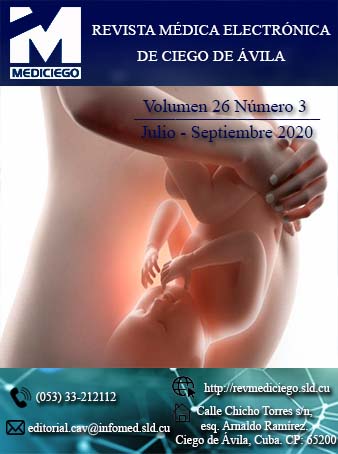Queratoglobo o ectasia corneal globular. Informe de caso
Palabras clave:
QUERATOGLOBO, ECTASIA/corneal, TOPOGRAFIA/ cornealResumen
Introducción: el queratoglobo es una enfermedad extremadamente rara, bilateral, que afecta a pacientes de ambos sexos y diferentes grupos étnicos. Se caracteriza por un adelgazamiento corneal, sin inflamación, difuso, de limbo a limbo. Debido a los defectos refractivos y fragilidad corneal que provoca, es importante su diagnóstico temprano.
Objetivo: describir las características clínicas de un paciente con queratoglobo, su diagnóstico y opciones terapéuticas.
Presentación del caso: paciente masculino de siete años edad, con miopía corregida por cristales. Acudió a la consulta de córnea por presentar disminución progresiva de la agudeza visual. La biomicroscopia del segmento anterior mostró adelgazamiento corneal central hasta la periferia media, protrusión corneal generalizada y cámaras anteriores profundas. La topografía corneal reveló valores queratométricos elevados en toda la superficie, fundamentalmente en la zona central. Mediante paquimetría se constató un adelgazamiento corneal ligero. Las manifestaciones oftalmológicas afectaban ambos ojos, más acentuadas en el izquierdo. El problema óptico se corrigió con lentes de contacto de gas permeable y el paciente fue seguido en la consulta de córnea.
Conclusiones: el manejo del queratoglobo es difícil en ocasiones, por los defectos refractivos que induce y la fragilidad corneal con consecuencias graves como perforación ocular y ambliopía. En el caso de este paciente la enfermedad no estuvo asociada a síndromes de herencia autosómica recesiva. El aporte científico de este trabajo estriba en la descripción detallada de las características del queratoglobo, su diagnóstico y opciones terapéuticas más ventajosas para el pacienteDescargas
Publicado
Cómo citar
Número
Sección
Licencia
Derechos de autor 2021 Karyna Castro Cárdenas, Yaney Zayas Ribalta, Mileidys Hernández Conde

Esta obra está bajo una licencia internacional Creative Commons Atribución-NoComercial 4.0.
Aquellos autores/as que tengan publicaciones con esta revista, aceptan los términos siguientes de la Licencia CC Attribution 4.0/ International/ Deed (CC BY 4.0):
Usted es libre de:
- Compartir — copiar y redistribuir el material en cualquier medio o formato para cualquier propósito, incluso comercialmente.
- Adaptar — remezclar, transformar y construir a partir del material para cualquier propósito, incluso comercialmente.
La licenciante no puede revocar estas libertades en tanto usted siga los términos de la licencia
Bajo las condiciones siguientes:
- Atribución — Usted debe dar crédito de manera adecuada , brindar un enlace a la licencia, e indicar si se han realizado cambios . Puede hacerlo en cualquier forma razonable, pero no de forma tal que sugiera que usted o su uso tienen el apoyo de la licenciante.
- No hay restricciones adicionales — No puede aplicar términos legales ni medidas tecnológicas que restrinjan legalmente a otras a hacer cualquier uso permitido por la licencia.
La revista no se responsabiliza con las opiniones y conceptos emitidos en los trabajos, son de exclusiva responsabilidad de los autores. El Editor, con la asistencia del Comité de Editorial, se reserva el derecho de sugerir o solicitar modificaciones aconsejables o necesarias. Son aceptados para publicar trabajos científico originales, resultados de investigaciones de interés que no hayan sido publicados ni enviados a otra revista para ese mismo fin.
La mención de marcas comerciales de equipos, instrumentos o materiales específicos obedece a propósitos de identificación, no existiendo ningún compromiso promocional con relación a los mismos, ni por los autores ni por el editor.






















